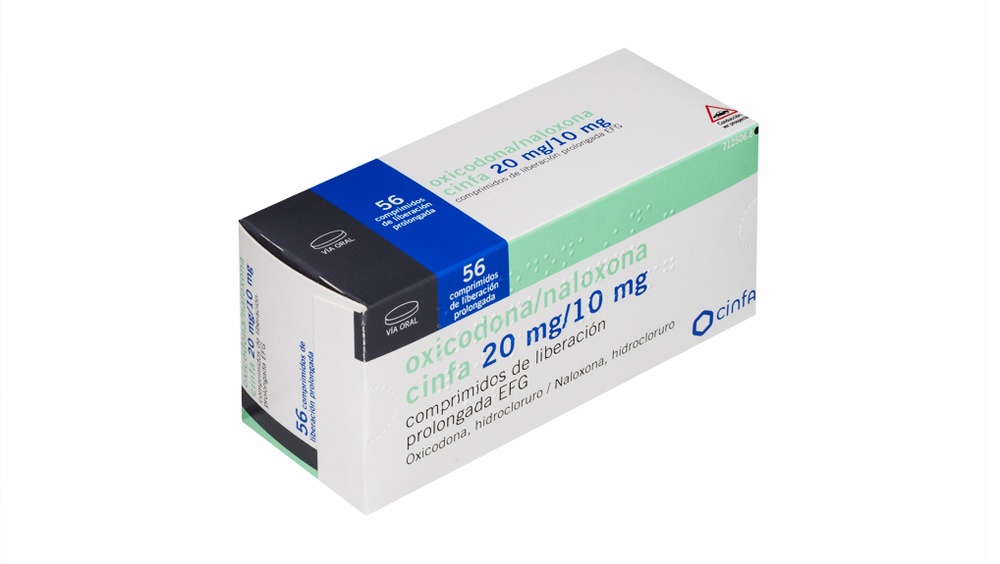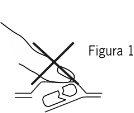

OXICODONE/NALOXONE CINFA 20 mg/10 mg PROLONGED-RELEASE TABLETS

Ask a doctor about a prescription for OXICODONE/NALOXONE CINFA 20 mg/10 mg PROLONGED-RELEASE TABLETS

How to use OXICODONE/NALOXONE CINFA 20 mg/10 mg PROLONGED-RELEASE TABLETS
Introduction
Package Leaflet: Information for the User
oxicodone/naloxone cinfa20 mg/10 mg prolonged-release tablets EFG
oxicodone, hydrochloride / naloxone, hydrochloride
Read all of this leaflet carefully before you start taking this medicine because it contains important information for you.
- Keep this leaflet, you may need to read it again.
- If you have any further questions, ask your doctor or pharmacist.
- This medicine has been prescribed for you only. Do not pass it on to others. It may harm them, even if their signs of illness are the same as yours.
- If you get any side effects, talk to your doctor or pharmacist. This includes any possible side effects not listed in this leaflet. See section 4.
Contents of the pack
- What oxicodone/naloxone cinfa is and what it is used for
- What you need to know before you take oxicodone/naloxone cinfa
- How to take oxicodone/naloxone cinfa
- Possible side effects
- Storage of oxicodone/naloxone cinfa
- Contents of the pack and other information
1. What oxicodone/naloxone cinfa is and what it is used for
Oxicodone/naloxone cinfa is a prolonged-release tablet, which means that the active substances are released over a longer period of time. Its effect lasts 12 hours.
This medicine is only intended for use in adults.
Pain relief
You have been prescribed oxicodone/naloxone for the treatment of severe pain, which can only be adequately managed with opioid analgesics. Hydrochloride of naloxone is added to counteract constipation.
How these tablets work for pain relief
These tablets contain hydrochloride of oxicodone and hydrochloride of naloxone as active substances. The hydrochloride of oxicodone is responsible for the analgesic effect of the medicine. It is a potent analgesic from the group of opioids. The second active substance of this medicine, hydrochloride of naloxone, has the function of counteracting constipation. Intestinal dysfunction (e.g., constipation) is a common side effect of treatment with opioid analgesics.
2. What you need to know before you take oxicodone/naloxone cinfa
Do not take oxicodone/naloxone cinfa:
- if you are allergic to hydrochloride of oxicodone, hydrochloride of naloxone or any of the other ingredients of this medicine (listed in section 6),
- if your breathing is not sufficient to provide enough oxygen to the blood or to remove the carbon dioxide produced by the body (respiratory depression),
- if you have severe lung disease associated with narrowing of the airways (chronic obstructive pulmonary disease or COPD),
- if you have a disorder known as cor pulmonale. This disorder consists of the right side of the heart increasing in size due to increased pressure inside the blood vessels of the lungs, etc. (e.g., as a result of COPD, see above),
- if you have severe bronchial asthma,
- if you have paralytic ileus (a type of intestinal obstruction) not caused by opioids,
- if you have moderate to severe liver disease.
Warnings and precautions
Consult your doctor or pharmacist before starting to take oxicodone/naloxone cinfa:
- if you are an elderly or debilitated patient (weak),
- if you have paralytic ileus (a type of intestinal obstruction) caused by opioids,
- if you have kidney disease,
- if you have mild liver disease,
- if you have severe lung disease (i.e., reduced breathing capacity),
- if you have a disease characterized by frequent pauses in breathing during sleep, which can make you feel very sleepy during the day (sleep apnea),
- if you have myxedema (a thyroid disorder characterized by dryness, coldness, and swelling of the skin, affecting the face and limbs),
- if your thyroid gland does not produce enough hormones (underactive thyroid, or hypothyroidism),
- if your adrenal glands do not produce enough hormones (adrenal insufficiency or Addison's disease),
- if you have a mental illness accompanied by a loss (partial) of the notion of reality (psychosis), due to alcoholism or intoxication with other substances (substance-induced psychosis),
- if you have problems with gallstones,
- if you have an abnormal increase in the size of the prostate (prostate hypertrophy),
- if you have pancreatitis (inflammation of the pancreas),
- if you have low blood pressure (hypotension),
- if you have high blood pressure (hypertension),
- if you have pre-existing cardiovascular disease,
- if you have had a head injury (due to the risk of increased pressure in the brain),
- if you have epilepsy or are prone to seizures,
- if you are also receiving treatment with MAO inhibitors (used to treat depression or Parkinson's disease), for example, medications that contain tranylcypromine, phenelzine, isocarboxazid, moclobemide, and linezolid,
- if you experience drowsiness or sudden sleep episodes.
Contact your doctor if you have severe abdominal pain that may radiate to the back, nausea, vomiting, or fever, as these may be symptoms associated with pancreatitis and biliary tract disease.
Inform your doctor if you have had any of these diseases in the past. Also, inform your doctor if you develop any of them during treatment with oxicodone/naloxone.
Tolerance, dependence, and addiction
This medicine contains oxicodone, which is an opioid medicine. Repeated use of opioid analgesics may make the medicine less effective (you get used to it, which is known as tolerance). Repeated use of oxicodone/naloxone may cause dependence, abuse, and addiction, which can lead to a life-threatening overdose. The risk of these side effects may increase with higher doses and longer treatment duration.
Dependence or addiction can make you feel that you no longer have control over the amount of medicine you need to take or how often you need to take it. You may feel that you need to continue taking the medicine even when it no longer helps to relieve your pain.
The risk of becoming dependent or addicted varies from person to person. You may have a higher risk of becoming dependent or addicted to oxicodone/naloxone:
- if you or a family member have a history of abuse or dependence on alcohol, prescription medicines, or illegal substances ("addiction").
- if you smoke.
- if you have ever had problems with your mood (depression, anxiety, or personality disorder) or have received psychiatric treatment for other mental health diseases.
If you notice any of the following signs while taking oxicodone/naloxone, it could be a sign that you have become dependent or addicted.
- You need to take the medicine for a longer period than recommended by your doctor.
- You need to take more doses than recommended.
- You are using the medicine for reasons other than those prescribed, for example, "to calm down" or "to help you sleep".
- You have made repeated attempts to stop or control the use of the medicine without success.
- You do not feel well when you stop taking the medicine and feel better once you take it again ("withdrawal symptoms").
If you notice any of these signs, talk to your doctor to discuss the best treatment for you, including when it is appropriate to stop taking it and how to do it safely (see section 3, If you stop taking oxicodone/naloxone).
The most serious consequence of an opioid overdose is respiratory depression (slow and shallow breathing). This can also cause the oxygen concentration in the blood to decrease, which can lead to fainting, etc.
Sleep-related breathing disorders
This medicine contains oxicodone, which is an opioid, and may cause dependence and/or addiction. |
Oxicodone/naloxone may cause sleep-related breathing disorders such as sleep apnea (pauses in breathing during sleep) and sleep-related hypoxemia (low oxygen levels in the blood). Symptoms may include pauses in breathing during sleep, nighttime awakenings due to difficulty breathing, difficulty maintaining sleep, or excessive daytime sleepiness. If you or someone else observes these symptoms, consult your doctor. Your doctor may consider reducing the dose.
Swallow the prolonged-release tablet whole, so that the slow release of hydrochloride of oxicodone from the tablet is not affected. Do not break, chew, or crush the tablets. If you do, your body may absorb a potentially fatal dose of hydrochloride of oxicodone (see section 3 "If you take more oxicodone/naloxone cinfa than you should").
If you experience severe diarrhea at the start of treatment, it may be due to the effect of naloxone. It may be a sign that bowel function is returning to normal. This diarrhea may occur in the first 3 to 5 days of treatment. If it persists beyond this 3 to 5-day period or if you are concerned, contact your doctor.
If you have been receiving another opioid, you may experience withdrawal symptoms shortly after starting treatment with oxicodone/naloxone, such as restlessness, sweating, and muscle pain. If you experience any of these symptoms, you may need special monitoring by your doctor.
You may develop tolerance if you use oxicodone/naloxone for a long time. This means that you will need a higher dose to achieve the desired effect. Long-term use of oxicodone/naloxone may also lead to physical dependence. Withdrawal symptoms may occur if treatment is stopped suddenly (restlessness, sweating, muscle pain). If you no longer need treatment, you should gradually reduce the daily dose, consulting your doctor.
The active substance hydrochloride of oxicodone alone has the same potential for abuse as other potent opioids (potent analgesics). It can create psychological dependence. Medicines containing hydrochloride of oxicodone should be avoided in patients with a history of alcohol, drug, or medicine abuse.
Inform your doctor if you have cancer associated with peritoneal metastases or the onset of intestinal obstruction in advanced stages of digestive or pelvic cancer.
If you need to undergo surgery, inform your doctor that you are taking oxicodone/naloxone.
Like other opioids, oxicodone may affect the normal production of hormones in the body, such as cortisol or sex hormones, especially if high doses are taken for long periods. If you notice persistent symptoms such as malaise (including nausea), loss of appetite, fatigue, weakness, dizziness, changes in menstrual cycle, impotence, infertility, or decreased sexual desire, consult your doctor so that they can monitor your hormone levels.
You may observe remains of the prolonged-release tablet in your stools. Do not be alarmed, as the active substances (hydrochloride of oxicodone and hydrochloride of naloxone) have already been released in the stomach and intestines and have been absorbed by your body.
Incorrect use of oxicodone/naloxone cinfa
Oxicodone/naloxone is not suitable for the treatment of withdrawal symptoms.
Never abuse oxicodone/naloxone, especially if you have a history of substance abuse. If you are addicted to substances such as heroin, morphine, or methadone, you may experience severe withdrawal symptoms if you misuse oxicodone/naloxone, as it contains naloxone. Pre-existing withdrawal symptoms may worsen.
Also, never dissolve the prolonged-release tablets of oxicodone/naloxone to inject them (e.g., into a blood vessel). The reason is that they contain talc, which can cause local tissue destruction (necrosis) and lung tissue changes (pulmonary granuloma). This incorrect use can also have other serious consequences and even lead to death.
The use of oxicodone/naloxone may result in positive doping tests. The use of oxicodone/naloxone as a doping agent can endanger health.
Other medicines and oxicodone/naloxone cinfa
Tell your doctor or pharmacist if you are taking, have recently taken, or might take any other medicines.
Concomitant use of opioids, including hydrochloride of oxicodone, and sedative medicines such as benzodiazepines or related medicines, increases the risk of drowsiness, breathing difficulties (respiratory depression), coma, and can be life-threatening. Due to this, concomitant use should only be considered when other treatment options are not possible.
However, if your doctor prescribes oxicodone/naloxone together with sedative medicines, your doctor should limit the dose and duration of concomitant treatment.
Inform your doctor about all sedative medicines you are taking and carefully follow the recommended doses prescribed by your doctor. It may be useful to inform friends or family members who are aware of the signs and symptoms indicated above. Contact your doctor when you experience these symptoms. Some examples of sedative medicines or related medicines are:
- other potent analgesics (opioids);
- sleeping pills and tranquilizers (sedatives, including benzodiazepines, hypnotics, anxiolytics);
- medicines for treating depression;
- medicines used to treat allergies, dizziness, or nausea (antihistamines or antiemetics);
- medicines used to treat psychiatric or mental disorders (antipsychotics, including phenothiazines and neuroleptics);
- muscle relaxants;
- medicines used to treat Parkinson's disease.
If you take these tablets at the same time as other medicines, the effects of the tablets or the other medicines described below may change. Inform your doctor if you are taking:
- medicines that reduce the blood's ability to clot (coumarin derivatives), the clotting speed may increase or decrease;
- macrolide antibiotics (such as clarithromycin, erythromycin, or telithromycin);
- azole-type antifungal agents (such as ketoconazole, voriconazole, itraconazole, or posaconazole);
- a specific type of medicine known as a protease inhibitor used to treat HIV (e.g., ritonavir, indinavir, nelfinavir, or saquinavir);
- cimetidine (a medicine used to treat stomach ulcers, indigestion, or heartburn);
- rifampicin (used to treat tuberculosis);
- carbamazepine (used to treat seizures or certain painful diseases);
- phenytoin (used to treat seizures or certain painful diseases);
- a herbal medicine called St. John's Wort (also known as Hypericum perforatum);
- quinidine (a medicine used to treat arrhythmias).
No interactions are expected between oxicodone/naloxone and paracetamol, acetylsalicylic acid, or naltrexone.
The risk of side effects increases if you use antidepressants (such as citalopram, duloxetine, escitalopram, fluoxetine, fluvoxamine, paroxetine, sertraline, venlafaxine). These medicines may interact with oxicodone and symptoms such as involuntary muscle contractions, agitation, excessive sweating, tremors, exaggerated reflexes, increased muscle tension, and body temperature above 38 °C may occur. Contact your doctor if you experience these symptoms.
Taking oxicodone/naloxone cinfa with food, drinks, and alcohol
Drinking alcohol while taking oxicodone/naloxone may make you feel more drowsy or increase the risk of serious side effects such as shallow breathing with the risk of stopping breathing and loss of consciousness. It is recommended not to drink alcohol while taking oxicodone/naloxone.
You should avoid drinking grapefruit juice while taking oxicodone/naloxone.
Pregnancy and breastfeeding
If you are pregnant or breastfeeding, think you may be pregnant, or are planning to have a baby, ask your doctor or pharmacist for advice before taking this medicine.
Pregnancy
Oxicodone/naloxone should be avoided during pregnancy whenever possible. If used during prolonged periods of pregnancy, hydrochloride of oxicodone may cause withdrawal symptoms in the newborn. If hydrochloride of oxicodone is administered during labor, the newborn may experience respiratory depression (slow and shallow breathing).
Breastfeeding
Breastfeeding should be discontinued during treatment with oxicodone/naloxone. Hydrochloride of oxicodone passes into breast milk. It is not known if hydrochloride of naloxone also passes into breast milk. Therefore, the risk to the breastfed child cannot be excluded, especially if the mother receives multiple doses of oxicodone/naloxone.
Driving and using machines
Ask your doctor if you can drive or use machines while taking oxicodone/naloxone. It is important that before driving or using machines, you observe how this medicine affects you. Do not drive or use machines if you feel drowsy, dizzy, have blurred vision, or double vision, or have difficulty concentrating. Be especially careful at the start of treatment, after a dose increase, after a change in formulation, and/or when administering it in combination with other medicines.
oxicodone/naloxone cinfa contains sodium
This medicine contains less than 1 mmol of sodium (23 mg) per tablet; this is essentially "sodium-free".
3. How to take oxycodone/naloxone cinfa
Follow the administration instructions for this medication exactly as indicated by your doctor or pharmacist. In case of doubt, consult your doctor or pharmacist.
Before starting treatment and periodically during treatment, your doctor will discuss with you what you can expect from the use of oxycodone/naloxone, when and for how long you should take it, when to contact your doctor, and when you should stop taking it (see also "If you stop treatment with oxycodone/naloxone").
Oxycodone/naloxone cinfa is a prolonged-release tablet, which means that the active ingredients are released over a prolonged period. Its action lasts 12 hours.
You must swallow the prolonged-release tablet whole to avoid affecting the slow release of oxycodone hydrochloride from the tablet . Do not break, crush, or chew the tablets.If you do, your body may absorb a potentially fatal dose of oxycodone hydrochloride (see section 3 "If you take more oxycodone/naloxone cinfa than you should").
Unless your doctor tells you otherwise, the recommended dose is:
For pain treatment
Adults
The initial recommended dose is 10 mg of oxycodone hydrochloride / 5 mg of naloxone hydrochloride in prolonged-release tablets every 12 hours.
Your doctor will decide the dose of oxycodone/naloxone you should take per day and how to divide the total daily dose between the morning and evening doses. Your doctor will also decide if it is necessary to adjust the dose during treatment. Your dose will be adapted to your degree of pain and individual sensitivity. You should receive the minimum necessary dose to relieve pain. If you have already received treatment with opioids, the initial dose of oxycodone/naloxone may be higher.
The maximum daily dose is 160 mg of oxycodone hydrochloride and 80 mg of naloxone hydrochloride. If you need a higher dose, your doctor may prescribe more oxycodone hydrochloride without naloxone hydrochloride. However, the maximum daily dose of oxycodone hydrochloride should not exceed 400 mg. The beneficial effect of naloxone hydrochloride on intestinal activity may be affected if the dose of oxycodone hydrochloride is increased without increasing the dose of naloxone hydrochloride.
If you replace these tablets with another opioid analgesic, your intestinal function may worsen.
If you experience pain between two doses of oxycodone/naloxone, you may need a rapid-acting analgesic. Oxycodone/naloxone is not suitable for treatment in this case. Consult your doctor.
If you feel that the effect of these tablets is too strong or too weak, consult your doctor or pharmacist.
Elderly patients
In general, it is not necessary to adjust the dose in elderly patients with normal kidney and/or liver function.
Liver or kidney disorder
If you have kidney disorder of any degree or mild liver disorder, your doctor will prescribe these tablets with special caution. If you have moderate or severe liver disorder, you should not take these tablets (see also section 2 "Do not take oxycodone/naloxone cinfa" and "Warnings and precautions").
Children and adolescents under 18 years of age
Oxycodone/naloxone has not been studied in children and adolescents under 18 years of age. Its safety and efficacy have not been demonstrated in these patients. For this reason, the use of oxycodone/naloxone is not recommended in children and adolescents under 18 years of age.
Method of administration
Oral route.
Swallow the tablets whole (without chewing), with sufficient liquid (half a glass of water). You can take the prolonged-release tablets with or without food. Take the tablets every 12 hours, following a fixed schedule (for example, at 8 am and 8 pm). Do not break, chew, or crush the prolonged-release tablets (see section 2 "Warnings and precautions").
Opening instructions:
This medication is available in a single-dose blister pack, peelable, perforated, and child-resistant.
- Do not crush the prolonged-release tablet
To avoid crushing the prolonged-release tablet, do not press the blister (Figure 1).

- Separate a blister
Each blister pack contains seven blisters, which are separated by perforations. Separate a blister by following the perforated lines, where it says "fold" (Figure 2).

- Remove the foil
Carefully remove the foil, starting from the corner marked with an arrow and where it says "pull here" (Figure 3).

- Remove the prolonged-release tablet
Remove the prolonged-release tablet, and swallow it whole (without chewing) with sufficient liquid (half a glass of water) (Figure 4).

Duration of treatment
In general, you should not take these tablets for longer than necessary. If you are given oxycodone/naloxone for a long time, your doctor should regularly check that you still need oxycodone/naloxone.
If you take more oxycodone/naloxone cinfa than you should
If you have taken more tablets than prescribed, you should inform your doctor immediately.
An overdose can cause:
- constriction of the pupils
- slow and shallow breathing (respiratory depression)
- drowsiness that can lead to loss of consciousness
- low muscle tone (hypotonia)
- decreased heart rate
- decreased blood pressure
- a brain disorder (known as toxic leukoencephalopathy)
In severe cases, loss of consciousness (coma), fluid accumulation in the lungs, and circulatory collapse may occur, which can be fatal in some cases.
You should avoid situations that require a high level of alertness, such as driving.
In case of overdose or accidental ingestion, consult your doctor or pharmacist immediately or call the Toxicology Information Service, phone 91 562 04 20, indicating the medication and the amount ingested.
If you forget to take oxycodone/naloxone cinfa
Or if you take a lower dose than prescribed, you may stop noticing the analgesic effect.
If you forget to take a dose, follow these instructions:
- If there are 8 hours or more left until the next normal dose:Take the forgotten dose immediately and continue with the normal schedule.
- If there are less than 8 hours left until the next normal dose: Take the forgotten dose. Wait another 8 hours before taking the next dose. Try to recover the original schedule (for example, 8 am and 8 pm). Do not take more than one dose in an 8-hour period.
Do not take a double dose to make up for forgotten doses.
If you stop treatment with oxycodone/naloxone cinfa
Do not stop treatment with oxycodone/naloxone without consulting your doctor.
If you no longer need to continue treatment, you should gradually reduce the daily dose after consulting your doctor. This will help you avoid withdrawal symptoms, such as restlessness, sweating, and muscle pain.
If you have any other questions about the use of this medication, ask your doctor or pharmacist.
4. Possible side effects
Like all medications, this medication can cause side effects, although not everyone will experience them.
Important side effects to consider and what to do if you experience them:
If you experience any of the following important side effects, consult your doctor immediately.
Slow and shallow breathing (respiratory depression) is the main danger of opioid overdose. It occurs mainly in elderly and debilitated patients. Opioids can also cause a significant decrease in blood pressure in susceptible patients.
The following side effects have been observed in patients receiving treatment for pain
Frequent(may affect up to 1 in 10 patients) | ||
|
|
|
|
|
|
|
|
|
|
|
|
|
|
|
|
|
|
|
|
Uncommon(may affect up to 1 in 100 patients) | ||
|
|
|
|
|
|
|
|
|
|
|
|
|
|
|
|
|
|
|
|
|
|
|
|
|
|
|
|
|
|
|
| |
|
| |
|
| |
| ||
| ||
|
Rare(may affect up to 1 in 1,000 patients) | ||
|
|
|
|
|
Frequency not known(cannot be estimated from available data) | ||
|
|
|
|
|
|
|
|
|
|
|
It is known that the active ingredient oxycodone hydrochloride, if not combined with naloxone hydrochloride, has the following side effects:
Oxycodone may cause respiratory problems (respiratory depression), constriction of the pupils, bronchial and smooth muscle spasms, and depression of the cough reflex.
Frequent(may affect up to 1 in 10 patients) | ||
|
|
|
|
|
Uncommon(may affect up to 1 in 100 patients) | ||
|
|
|
|
|
|
|
|
|
|
|
|
|
|
|
|
|
|
|
|
Rare(may affect up to 1 in 1,000 patients) | ||
|
|
|
|
|
Frequency not known(cannot be estimated from available data) | ||
|
|
|
|
|
|
Reporting side effects
If you experience any side effects, consult your doctor or pharmacist, even if they are possible side effects that do not appear in this leaflet. You can also report them directly through the Spanish Pharmacovigilance System for Human Use Medicines: https://www.notificaram.es. By reporting side effects, you can contribute to providing more information on the safety of this medication.
5. Storage of oxycodone/naloxone cinfa
Keep this medication out of sight and reach of children. Store this medication in a safe and closed place, where others cannot access it. It can cause serious harm and be fatal to people who have not been prescribed it.
Do not use this medication after the expiration date that appears on the packaging and the blister pack, after CAD. The expiration date is the last day of the month indicated.
This medication does not require special storage conditions.
Medications should not be thrown down the drain or into the trash. Deposit the packaging and medications you no longer need at the SIGRE collection point in your pharmacy. If in doubt, ask your pharmacist how to dispose of the packaging and medications you no longer need. This will help protect the environment.
6. Container Content and Additional Information
Oxycodone/Naloxone Cinfa Composition
- The active ingredients are oxycodone hydrochloride and naloxone hydrochloride.
Each prolonged-release tablet contains 20 mg of oxycodone hydrochloride, equivalent to 18 mg of oxycodone, and 10 mg of naloxone hydrochloride in the form of 11.00 mg of naloxone hydrochloride dihydrate, equivalent to 9.01 mg of naloxone.
- The other components are: tablet core:hypromellose 603, polyvinyl acetate dispersion 30%, povidone K30, sodium lauryl sulfate, anhydrous colloidal silica, microcrystalline cellulose PH 102, silicon dioxide, magnesium stearate. tablet coating:polyvinyl alcohol, titanium dioxide (E-171), macrogol 3350, talc, red iron oxide (E-172), yellow iron oxide (E-172).
Appearance ofoxycodone/naloxone cinfaand container content
Prolonged-release tablet.
Coated tablets are pink, elliptical, biconvex, and engraved with "20" on one side.
Oxycodone/naloxone cinfa prolonged-release tablets are available in child-resistant, peelable, perforated blister packs with a polyamide-aluminum-PVC/aluminum-PET film.
Package sizes: 20, 28, 30, 50, 56, and 100 tablets.
Not all package sizes may be marketed.
Marketing Authorization Holder
Laboratorios Cinfa, S.A.
Carretera Olaz-Chipi, 10. Polígono Industrial Areta
31620 Huarte (Navarra) - Spain
Manufacturer
Laboratorios Cinfa, S.A.
Carretera Olaz-Chipi, 10. Polígono Industrial Areta
31620 Huarte (Navarra) - Spain
Or
Ethypharm
Chemin de la Poudrière
76121 Le Grand Quevilly
France
Date of the last revision of this prospectus:January 2025
Detailed and updated information on this medicinal product is available on the website of the Spanish Agency for Medicines and Health Products (AEMPS) http://www.aemps.gob.es/
You can access detailed and updated information about this medicinal product by scanning the QR code included in the prospectus and packaging with your mobile phone (smartphone). You can also access this information at the following internet address: https://cima.aemps.es/cima/dochtml/p/81211/P_81211.html
QR code to: https://cima.aemps.es/cima/dochtml/p/81211/P_81211.html

How much does OXICODONE/NALOXONE CINFA 20 mg/10 mg PROLONGED-RELEASE TABLETS cost in Spain ( 2025)?
The average price of OXICODONE/NALOXONE CINFA 20 mg/10 mg PROLONGED-RELEASE TABLETS in December, 2025 is around 50.77 EUR. Prices may vary depending on the region, pharmacy, and whether a prescription is required. Always check with a local pharmacy or online source for the most accurate information.
- Country of registration
- Average pharmacy price50.77 EUR
- Active substance
- Prescription requiredYes
- Manufacturer
- This information is for reference only and does not constitute medical advice. Always consult a licensed doctor before taking any medication. Oladoctor is not responsible for medical decisions based on this content.
- Alternatives to OXICODONE/NALOXONE CINFA 20 mg/10 mg PROLONGED-RELEASE TABLETSDosage form: MODIFIED-RELEASE TABLET, 10 mg/5 mgActive substance: oxycodone and naloxoneManufacturer: Neuraxpharm Spain S.L.Prescription requiredDosage form: MODIFIED-RELEASE TABLET, 20 mg/10 mgActive substance: oxycodone and naloxoneManufacturer: Neuraxpharm Spain S.L.Prescription requiredDosage form: MODIFIED-RELEASE TABLET, 30 mg/15 mgActive substance: oxycodone and naloxoneManufacturer: Neuraxpharm Spain S.L.Prescription required
Alternatives to OXICODONE/NALOXONE CINFA 20 mg/10 mg PROLONGED-RELEASE TABLETS in other countries
The best alternatives with the same active ingredient and therapeutic effect.
Alternative to OXICODONE/NALOXONE CINFA 20 mg/10 mg PROLONGED-RELEASE TABLETS in Poland
Online doctors for OXICODONE/NALOXONE CINFA 20 mg/10 mg PROLONGED-RELEASE TABLETS
Discuss dosage, side effects, interactions, contraindications, and prescription renewal for OXICODONE/NALOXONE CINFA 20 mg/10 mg PROLONGED-RELEASE TABLETS – subject to medical assessment and local rules.














